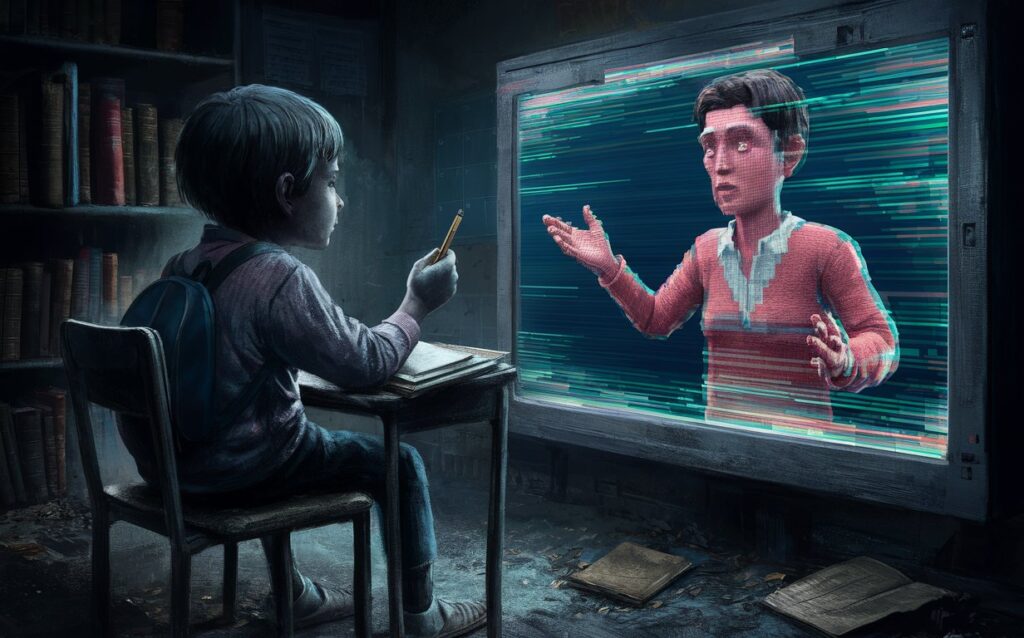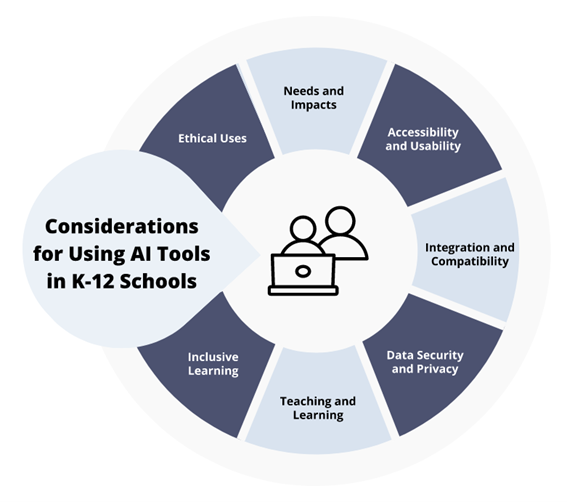
Image generated using Ideogram AI.
By Mariana Meneses
Google has launched Gemini for Google Workspace for education by integrating generative AI tools into familiar apps like Docs, Gmail, and Slides.
These new add-ons, available to schools for a subscription fee, are aimed at helping educators with tasks such as creating lesson plans, summarizing emails, and developing presentations. Features include “AI-powered note-taking,” generating “original images” to bring a presentation “to life,” and guided practice quizzes.
Google claims the AI services it’s selling to schools have “the potential to help students, educators and education communities save time, create captivating learning experiences, inspire creativity and learn with confidence.” The company, which generated a profit of $74 billion in 2023, is one of a number of commercial actors promoting the use of AI in education.
According to the 2024 UK Parliament Research briefing on the use of AI in education, AI tools have the potential to transform education by providing new learning methods and assisting educators with tasks like lesson planning and grading. However, concerns have been raised about the over-use of virtual technology in the education context, which could undermine educator-learner relationships and negatively affect learners’ writing and critical thinking skills.
There are already significant concerns about the effects of AI-powered applications on the learning experience. Recently, five school boards and two private schools in Ontario, Canada joined a multibillion-dollar lawsuit against Facebook, Instagram, TikTok, and Snapchat, claiming these social media platforms negatively impact students’ well-being and academic performance. The new $2.6 billion lawsuits follow a $4.5 billion suit filed in March by several other Ontario school boards.
The legal action argues that social media products have altered children’s thinking and behavior, causing significant distractions and mental health issues in schools. Ontario’s Education Minister, however, criticized the lawsuits, suggesting collaboration and proactive measures instead. Meta, TikTok, and Snapchat defended their platforms, highlighting ongoing efforts to enhance safety and support for teens.

Official logo of the World Economic Forum. Image: WEF) Commons-Media Gallery.(
According to the World Economic Forum’s Shaping the Future of Learning: The Role of AI in Education 4.0, education systems worldwide are facing both challenges and opportunities. The Global Teacher Gap, as projected by UNESCO, highlights a need for an additional 44 million teachers by 2030 to meet the United Nations’ Sustainable Development Goal 4, which aims for inclusive and equitable education for all. Schools also struggle with managing administrative tasks and accurately assessing students’ progress. Additionally, as technology advances, there is a growing need to teach digital skills.
The World Economic Forum asserts that AI can support teachers by automating routine tasks, allowing them to focus on building relationships and understanding individual student needs.
Moreover, AI can refine assessment processes, providing more accurate evaluations and valuable insights into student progress, and integrating AI into the curriculum helps students to develop essential AI and digital literacy skills. AI can personalize learning content, adapting to each student’s needs, preferences, and learning styles, which can significantly boost engagement and outcomes.
The World Economic Forum’s Shaping the Future of Learning: The Role of AI in Education 4.0 cites a few promising case studies of the use of AI in education worldwide, including:
- The AI Tutor Project by the UAE Ministry of Education, in collaboration with Microsoft, ASI, and teachers, uses adaptive learning algorithms and data-driven insights to provide personalized, multilingual education, enhance academic performance, and alleviate teacher workload through real-time analytics and interactive learning.
- The South Korean Ministry of Education plans to introduce AI-powered digital textbooks in elementary and secondary schools by 2025. It aims to reduce educational inequality and reliance on private education, offering customized learning opportunities and fostering collaboration between human teachers and AI for personalized, interactive learning experiences. A pilot program is underway involving 400 teachers for real-time data collection and tailored student support.
- The AI for Youth Entrepreneurship Curriculum developed by non-profit organization JA Europe equips youth with foundational AI knowledge in coding and other tasks, including ethics and data literacy, fostering entrepreneurship and employment in sectors like agriculture. Expanding to 10 additional countries, the program aims to reach 30,000 youth, enabling them to develop AI-based solutions and business plans with support from chip-making company Intel, with a focus on promoting educational equity and providing underserved schools and refugees with digital skills.
- 3D Africa for Girls, led by the Youth for Technology Foundation, empowers girls aged 10-16 in Nigeria in STEM (Science, Technology, Engineering, and Mathematics) subjects, emphasizing 3D design and prototyping to develop and market innovative solutions, addressing the gender gap in AI careers and fostering interest in STEM subjects.
- The School Cyber Security Challenges / Cyber Skills Aotearoa, led by Grok Academy in Australia, provides teachers with resources to educate students aged 5-12 on cybersecurity, including information privacy and digital forensics. It engages over 91,000 students in Australia and New Zealand through courses, competitions, and resources. This initiative prepares the next generation with essential cybersecurity skills, addresses gender gaps in cybersecurity participation, and educates families on cybersecurity and misinformation.
- Leveraging Literacy through AI, developed by U.S.-based nonprofit organization Worldreader, uses AI technology to enhance literacy skills in low-income countries by providing personalized reading recommendations and feedback based on students’ reading patterns and preferences. Partnering with schools and communities, the program aims to improve reading comprehension and overall literacy levels, fostering a love for reading among children and enhancing educational outcomes for disadvantaged youth.
- Skill-building with Virtual Mentors is an initiative by the World Bank Group that uses AI-powered virtual mentors to provide personalized career guidance and skills development to youth in developing countries, offering tailored advice on career paths and educational opportunities through interactive chatbots, aiming to enhance employability and bridge the skills gap.
- The Accessible Digital Textbooks (ADT) initiative managed by United Nations’ agency UNICEF utilizes AI and Universal Design for Learning (UDL) principles to create customizable digital tools that cater to diverse learners, including those with disabilities, by offering features like narration, sign-language videos, and text-to-speech functions. This AI-driven approach aims to transform education, improve learning outcomes, and promote inclusive and personalized education for children with disabilities globally.
Caution is necessary to preserve and enhance the human skills of educators and students.
Research suggests that generative AI tools like ChatGPT can pass some exams, posing risks to the validity of assessment methods. Thus, successful implementation of AI in education requires evidence of its effectiveness, proper training and guidance for educators, and clarity on legal frameworks for data use. Addressing digital divides is also crucial to ensure AI tools are accessible to disadvantaged groups and do not exacerbate existing inequalities.
Understanding regional differences is essential for a holistic approach to addressing the concerns around the use of AI in education.
Regional differences in education have been studied by Dr. Luciana Allan, who holds a PhD in Education from the University of São Paulo (USP) in Brazil, and has led national and international education projects for over 20 years. She compares the perspectives of Brazilian and British educators on the use of AI in education, highlighting key differences between the two countries. In the UK, there is a significant fear among educators regarding AI, with 64% worried about job loss and 67% opposing the use of AI by students, largely due to concerns over its consequences to employment and teaching methods.
Conversely, in Brazil, there is a more optimistic outlook; 97% of Brazilian respondents believe that the teaching profession will not disappear due to AI, reflecting a strong belief in the irreplaceable value of the teacher-student relationship. Additionally, 82.7% of Brazilian educators support the use of AI in learning processes, compared to only 33% in the UK.
Despite these differing attitudes, both countries recognize the need for regulated and strategic integration of AI in education. Dr. Allan underscores that while Brazilian educators are generally more receptive to AI, they face unique challenges such as outdated teaching methods and unequal access to technology, necessitating a thoughtful and inclusive approach to adopting AI in education.

Image generated using Ideogram AI.
“AI does not substitute humans, it lowers costs” – Dr. Átila Iamarino
Dr. Átila Iamarino, a biologist and former postdoctoral researcher at Yale University, is one of Brazil’s most popular science communicators, having played a crucial role in combating misinformation during the COVID-19 pandemic. For Dr. Iamarino, the recent hype surrounding Artificial Intelligence (AI), especially large language models like OpenAI’s ChatGPT and Google’s Gemini, poses more challenges than benefits for the future of education.
To Dr. Iamarino, while AI tools can generate coherent text and assist in educational processes, they lack true understanding and can produce subtle but significant errors. Historical examples show that new technologies were expected to revolutionize education but ultimately didn’t replace the essential human element of learning.
The importance of human interaction in education cannot be overstated, and relying on AI to create, guide, or evaluate educational content could be problematic – and especially so in certain regions of the world.
Large language models like ChatGPT and Gemini, which generate plausible text based on predictions, are prone to “hallucinations” which can lead to misinformation and bias, particularly in diverse and context-specific educational settings. AI’s potential to improve education without substantial human oversight has not been established, and while it promises to generate profits for AI developers there is also a need to compensate teachers fairly for their time and enrich the time they spend preparing for and engaging with students.
While AI can be a powerful tool when used correctly, there is no basis to think that it can replace the crucial human elements of teaching and learning.
Craving more information? Check out these recommended TQR articles:
- Race for Post-Quantum Cryptography: Will Proposed Encryption Standards Secure the World’s Data?
- What Will a Recent Quantum Leap in Time Crystal Technology Reveal About the Elusive Nature of Time?
- Adaptive Intelligence: The Power of Genetic Mutations and Neural Networks
- Citizen Action Combines With Innovative New Methods to Combat Cybersecurity Threats
- The Incredible Power of Shape: Fractals Connect Quantum Computers to the Human Body and the Cosmos




